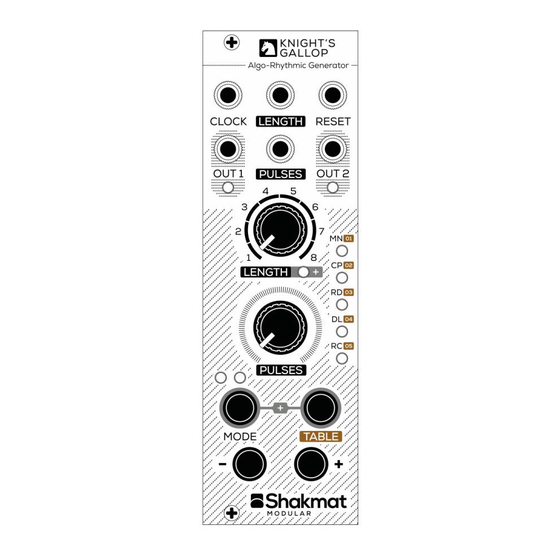
Table of Contents
Advertisement
Quick Links
Advertisement
Table of Contents

Summary of Contents for Shakmat Modular Knight's Gallop
- Page 1 KNIGHT’S GALLOP ALGO-RHYTHMIC GENERATOR BUILDING GUIDE...
-
Page 2: Table Of Contents
Table of Contents 01. Components List + Tools 02. PCB Sides 03. Important Note 04. Top PCB Assembly 04_1. Diode 1N4148 04_2. Laying Resistors 04_3. Zenner Diode 04_4. Capacitors 04_5. Quartz 04_6. 78L05 Regulator 04_7. Standing Resistors 04_8. Jack Connectors 04_9. -
Page 3: Components List + Tools
01. Components List + Tools Jack Knurled Nuts Resistors LED’s X6 — Pack 4/5 on jack connectors 6,8 kΩ White LED Potentiometers X6 — Pack 1/5 X1 — Pack 1/5 R7 → R10, R19, R20 L+ LED X2 — Pack 3/5 P1 &... -
Page 4: Pcb Sides
02. PCB Sides LED1 LED2 ICS1 LED M1 PSH1 LED M2 ICS2 L+ LED LED M3 LED M4 LED M5 Front Rear LED SM1 LED SM2... -
Page 5: Important Note
03. Important Note If you feel you're going to build this kit without looking at the steps, just remember that it is very important to join the two PCB’s in a strict parallel alignment. If you don't want the final build to have hard to press buttons, please pay attention to that. -
Page 6: 04_2. Laying Resistors
04_2. Laying Resistors Here's a picture of the top PCB with placement of the resistors by values. There’s polarity to observe with resistors. Pack 1/5 6.8k Pack 2/5 100k Pack 2/5 04_3. Zenner Diode Pack 2/5 Zenner As in step 4_1, be carefull to the diode polarity. -
Page 7: 04_5. Quartz
04_5. Quartz Pack 2/5 16 MHz 04_6. 78L05 Regulator Bend the middle leg of the 78L05. Then place the component on the PCB, the flat side of it has to correspond to the flat side of the silkscreen. Pack 1/5 78L05 04_7. -
Page 8: 04_8. Jack Connectors
04_8. Jack Connectors There are 6 jack connectors, that have to sit tight and flush with the PCB. Be sure to push them all the way through before soldering. X6 Pack 3/5 Jack 04_9. Potentiometers First you'll have to remove a little piece on the potentiometer as shown in the picture. -
Page 9: 04_10. Ic Sockets
04_10. IC Sockets Now, let’s flip the PCB and conti- nue. We’re going to solder the two ICs sockets. Be attentive to their orientation. The red lines on the picture show the right position. Plastic Tubbing 04_11. PCB Male Header The PCB header is also mounted on the back of the top PCB. -
Page 10: 04_12. Power Supply Header
04_12. Power Supply Header Pack 3/5 Header 05. Bottom PCB Assembly 05_1. Standing Resistors Pack 1/5 Pack 2/5 100k 05_2. Push Buttons The buttons are easy to plug & solder but they need to be thoroughly pushed on the PCB. Before soldering, we recommand to place the four buttons, then flip the PCB and press it against your table in order to ensure that every button is well... -
Page 11: Top & Bottom Pcb's Assembly
06. Top & Bottom PCB’s Assembly Be very carefull that the header you’re soldering is well passed through all the bottom PCB holes and that the two PCB’s are perfectly horizontal. If there is a gap between the header and the PCB’s, or if they’re not correc- tly aligned, the push button could be pourly placed and hard to press. - Page 12 POLARITY Masking tape Pack 3/5 Green Pack 2/5 Pack 4/5 Amber Nuts Pack 1/5 White...
-
Page 13: Ic's, Nuts, Bolt & Caps
08. IC’s, Nuts, Bolt & Caps It’s now time to plug the IC’s in their sockets. Make sure the IC orientation matches the socket orientation as on the following picture. Plastic Tubbing Pack 4/5 Pack 4/5 You can now place the six knurled nuts on the jack connectors and the M3 nut on the screw that is mounted on the back side of the panel. - Page 14 Plug the power cable and make sure the red side of the ribbon matches the -12V on the PCB. Now let's plug the module in your system and test it. The module LEDs doesn't blink if the module isn't running. So don't panic if the modules seems quiet when nothing is connected to it.
Need help?
Do you have a question about the Knight's Gallop and is the answer not in the manual?
Questions and answers